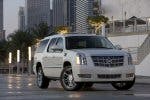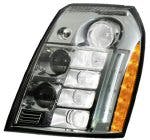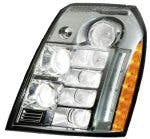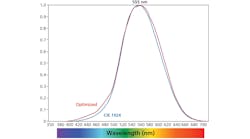The special edition vehicle will begin series production in summer 2008, shortly after the standard Cadillac Escalade is launched.
LEDs are already used on the Lexus LS600h for the low-beam headlamp function, and full-LED headlamps (low and high beam functions) will soon be available as an option on the new Audi R8. The November/December issue of LEDs Magazine contains several articles on LED headlamps.
Each LED headlamp contains a total of seven glass lenses, and only two are identical, all the others are of different shapes.
The four cushion-shaped freeform glass lenses create the symmetrical basic light distribution with large dispersion, which provides homogeneous illumination of the close range in front of the vehicle.
The daytime running light function is created by dimming the low beam (i.e. using the same 5 lenses).
Two additional free form projection lenses are responsible for the high beam; these are situated at the inner edge of the headlamp housing. All 7 lenses are illuminated when the high-beam is on.
The position light is designed as a light-guide rod placed vertically between the low beam and the side marker; two white standard LEDs are coupled into the light-guide. On the very outer edge of the headlamp, the side-marker light contains seven vertically arranged amber standard LEDs.
Direction indicators and fog lamps (not using LEDs) in the Cadillac Escalade Platinum are mounted in the lower area of the bumper.
Hella is using newly developed multi-chip LEDs as light sources for low beam and high beam. A high-performance ventilator developed especially for the particularly demanding requirements in the automotive sector is responsible for thermal management in the headlamp, and takes over the active cooling and ventilation of the LED chips.
Approval situation
In the USA, headlamps with LEDs for main lighting functions are already permissible according to the SAE standards applicable there. In Europe, or in the area governed by ECE regulations, approval is expected by 2008. Signal functions in the headlamp (direction indicator, side marker light, position light, daytime running light and cornering light) are already permissible, both in ECE and SAE areas.
Advantages of using LEDs
There are several advantages of using LEDs in headlamps. With a color temperature of around 5,500 K, the white LEDs are considerably closer to daylight (approx. 6,000 K) than that of Xenon light (approx. 4,000 K).
This comes close to what people are used to seeing. The driver does not tire as quickly and is more relaxed. In addition, the white LEDs are highly effective thanks to their quick response time and two functions (such as low beam and daytime running light) can be covered with one light source.
LED headlamps also open up new, far-reaching styling options giving far greater differentiation potential for vehicle manufacturers.








